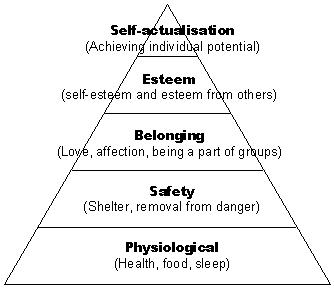It’s January, and I find myself reflecting on new beginnings, for fairly obvious reasons. And as I do so, it strikes me that some of the basic assumptions about effective leadership are quite often left unspoken.
With the 1943 development of Abraham Maslow’s theory of the hierarchy of needs (which, perhaps not coincidentally, dovetailed with the worst of the Second World War), we gained insight into what motivates most people at the most basic levels.
As a refresher, Maslow theorized the people must, in general, meet the needs at the lower levels of his “pyramid” or hierarchy before they could turn their energy and attention to meeting needs at higher levels. Physiological and safety needs form the basic two levels of the pyramid; bosses prior to World War II tended to lead through power by leveraging these two levels, either by providing for them or by threatening to withdraw what people needed to meet them.
For the better part of the last century, very few people in North America questioned whether it was a “best practice” to lead through the exertion of pure power.
We had, at least in most organizational settings, left that kind of leadership behind.
But apparently, the appeal of “You’re fired!” never completely lost its allure. After all—that approach is quick. It’s undeniably effective, inasmuch as it immediately removes a perceived “people problem.”
And it puts others on notice—fall in line or you’ll be next. The boss is the boss! Why not just own that power and whip it out from time to time, rather than dedicating time and effort to building relationships with subordinates, anyway?
How People React to Power
“Nobody likes to lose; nobody enjoys relationships that tip the favor of benefits in favor of the other person; nobody wants to be coerced into doing something that results in deprivation. No wonder power provokes such a variety of reactions in people—fighting it, avoiding it, defending against it, or trying to nullify its effects on them.” Dr. Thomas Gordon, Leader Effectiveness Training, p. 171
How to lead is always, ultimately, up to the individual leader. But the choice to use power (Method I, or Win-Lose) to resolve conflicts will result in predictable consequences.
Reduction in upward communication
Unsurprisingly, if a leader tends to shoot the messenger when he or she gets news that is displeasing, then the amount of news the leader receives will tend to drop—often dramatically. The accuracy of information that filters its way all the way up to the top can also be compromised, due to fear of provoking angry or retributive uses of power. The name of the game becomes, “tell the boss whatever he or she wants to hear.” What could possibly go wrong?
Buttering up and other ingratiating reactions
Flattery, currying favor, an ever-growing chorus of yes-men and yes-women; leaders who lean on the use of power create the circle of followers they want, and usually, it’s a group of people who are willing to say or do anything to earn a spot in the favored inner circle. Unfortunately, that’s a recipe for Groupthink, which has led to such notable historical debacles as the Bay of Pigs invasion, Watergate, and the Japanese attack on Pearl Harbor (to name just a few times not-so-well-thought-out exercises in “Whatever you say, boss” ended badly).
 Destructive competitiveness and rivalry
Destructive competitiveness and rivalry
On the peer-to-peer level, followers of a leader who uses power can become exceedingly ruthless toward each other in a toxic form of “sibling rivalry.” At this point, they lose sight of the higher goal— the good of the organization—and may even be willing to undermine projects that would ultimately benefit the boss if another person would receive credit and praise for it.
Submission and conformity
The exact opposite reaction—doing exactly what is specifically requested by the boss, no more and no less—is another coping mechanism some followers use to avoid punishment, even if an order is nonsensical or obviously erroneous (“Sure, this document says to ship 1,000 parts to a site that never needed more than 100 before, but I’m not going to be the one to question authority.”)
Rebellion and defiance
In organizations where there is some protection from being thrown out into the cold, another coping mechanism to the use and abuse of power may be to become the person who questions and resists literally every directive, no matter how small, and becomes a drain on morale and an obstacle in every group project.
Forming alliances and coalitions
When power is used and abused with enough regularity, some of those who are regularly threatened with rewards and punishments will inevitably start to communicate with each other informally to try to re-balance the imbalance of power. Work slowdowns, sick-outs, work-arounds, sabotage, and trade union formation are examples of this in the workplace.
Withdrawing and escaping
“Keep your head down; stay out of her way; don’t let her corner you. And when all else fails, you can quit.” Pushed to their limits, people will react to the toxic exercise of power by seeking to avoid the person who wields it.
Alternatives to Using Power
There are, thankfully, time-tested and evidence-based ways for leaders to work higher on the hierarchy of needs, appealing to people’s desire for belonging, esteem, and self-actualization rather than instilling fear through denial of the most basic needs. And organizations that invest in training leaders in the no-lose method of leadership will be rewarded in the long run with higher-quality decisions, increased commitment to carrying out decisions reached by true consensus, healthier relationships, and less turnover. Learn more about how to avoid the pitfalls of pure power through Leader Effectiveness Training—in 2017 and beyond.


